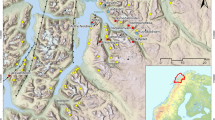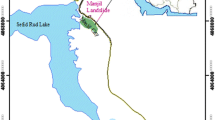Abstract
A 200 m long segment of the only main road in NW-Gran Canaria is built on landslide deposits near the village of El Risco. Structural mapping and analysis of the topography reveal that the N–S striking landslide head scarp is the upper part of a sub-circular failure surface. The southern side of the landslide is delimited by a much older E–W strike-slip fault. Prior to pavement resurfacing in 2006, cracks in the road tarmac at the northern and southern sides of the landslide suggested ongoing creep movement. Slope stability analyses suggest that peak ground acceleration (PGA) was the most likely trigger for the initial failure.
Résumé
La seule route majeure desservant le nord-ouest de Grande Canarie est construite sur les dépôts d’un glissement de terrain sur une longueur de 200 m, près du village d’El Risco. Une cartographie structurale et l’analyse de la topographie ont révélé que l’escarpement de tête, de direction N–S, constitue la partie supérieure d’une surface de rupture sub-circulaire. La partie sud du glissement est délimitée par une faille orientée E–W. Avant l’application d’une nouvelle couche d’asphalte en 2006, des fissures dans la chaussée coïncidaient avec les limites du glissement et auraient pu correspondre à un lent mouvement de fluage en cours. Les analyses de stabilité des pentes indiquent qu’une accélération séismique est la cause la plus probable de la rupture initiale.







Similar content being viewed by others
References
Apuani T, Corazzato C, Cancelli A, Tibaldi A (2005) Physical and mechanical properties of rock masses at Stromboli: a dataset for volcano instability evaluation. Bull Eng Geol Environ 64(4):419–431
Bishop AW (1955) The use of slip circles in the stability analysis of slopes. Géotechnique 5:7–17
Bear J (1972) Dynamics of fluids in porous media. Environmental Science Series. American Elsevier, New York, 764 pp
Bogaard Pvd, Schmincke H-U (1998) Chronostratigraphy of Gran Canaria. In: Weaver PPE, Schmincke H-U, Firth JV, Duffield W (eds) Proceedings of the ocean drilling program, scientific results 157. Ocean drilling program, College Station, TX, pp 127–140
Cabrera MC, Custodio E (2004) Groundwater flow in a volcanic-sedimentary coastal aquifer: Telde area, Gran canaria, Canary Islands, Spain. Hydrogeol. J 12(3):305–320
Campbell KW, Bozorgnia Y (1994) Near-source attenuation of peak horizontal acceleration from worldwide accelerograms recorded from 1957 to 1993. In: Institute EER (ed), 5th US National Conference on Earthquake Engineering, Berkeley, California, pp 283–292
Concha-Dimas A (2004) Numerical modelling in understanding catastrophic collapse at Pico de Orizaba, Mexico. PhD Thesis, University of Nevada, Reno
Funck T, Schmincke H-U (1998) Growth and destruction of Gran Canaria deduced from seismic reflection and bathymetric data. J Geophys Res 103:15393–15407
González de Vallejo LI, Capote R, Cabrera L, Insua JM, Acosta J (2003) Paleoearthquake evidence in Tenerife (Canary Islands) and possible seismotectonic sources. Marine Geophys Res 24(1–2):149–160
Hoek E, Kaiser PK, Bawden WF (1995) Support of underground excavations in hard rock. Balkema, Rotterdam
Hürlimann M, Marti J, Ledesma A (2000) Mechanical relationship between catastrophic volcanic landslides and caldera collapses. Geophys Res Lett 27(16):2393–2396
Instituto Nacional de Estadística, Poblaciones referidas al 1 de enero de 2006 por Islas y sexo. http://www.ine.es/inebase/cgi/axi?AXIS_PATH=/inebase/temas/t20/e260/a2006/l0/&FILE_AXIS=is01.px&CGI_DEFAULT=/inebase/temas/cgi.opt&COMANDO=SELECCION&CGI_URL=/inebase/cgi/. Retrived 15 Jan 2007
Instituto Geográfico Nacional, Ministerio de Fomento, Información sísmica, boletines definitivos de sismos próximos (1993–2004). http://www.fomento.es/MFOM/LANG_CASTELLANO/DIRECCIONES_GENERALES/INSTITUTO_GEOGRAFICO/Geofisica/sismologia/informacionsis/default.htm. Retrieved 15 Jan 2007
Janbu N (1957) Earth pressure and bearing capacity by generalized procedure of slices. In: Proceedings of the fourth international conference on soil mechanics, pp 207–212
Joyner WB, Boore DM (1993) Methods for regression analysis of strong-motion data. Bull Seismol Soc Am 83(2):469–487
Keefer DK (2002) Investigating landslides caused by earthquakes - a historical review. Surv Geophy 23(6):473–510
McDougall I, Schmincke H-U (1977) Geochronology of Gran Canaria, Canary Islands: age of shield building volcanism and other magmatic phases. Bull Volcanol 40(1):57–77
Mezcua J, Burforn E, Udías A, Rueda J (1992) Seismotectonics of the Canary Islands. Tectonophys 208:447–452
Okamoto S (1984) Introduction to earthquake engineering. University of Tokyo Press, pp 629
Population Division of the Department of Economic and Social Affairs of the United Nations Secretariat, World Population Prospects: The 2004 Revision and World Urbanization Prospects: The 2003 Revision. http://esa.un.org/unpp. Retrieved 15 Jan 2007
Schmincke H-U (1967) Cone sheet swarm, resurgence of Tejeda caldera, and the early geologic history of Gran Canaria. Bull Volcanol 31:153–162
Schmincke H-U (1976) The geology of the Canary Islands. In: Kunkel G (eds) Ecology and biogeography in the Canary Islands. The Hague, Netherlands, Junk B V, pp 67–184
Spencer E (1967) Method of analysis of the stability of embankments assuming parallel interslices forces. Géotechnique 17(1):11–26
Thomas ME, Petford N, Bromhead EN (2004) Volcanic rock-mass properties from Snowdonia and Tenerife: implications for volcano edifice strength. J Geol Soc 161:939–9046
Troll V R, Walter T R, Schmincke H-U (2002) Cyclic caldera collapse: piston or piecemeal subsidence? Field and experimental evidence. Geol 30:135–138
Varnes DJ (1978) Slope movements types and processes. Landslides Analysis and Control Transportation Research Board. National Academy of Sciences Special Report 176. Chapter 2, pp 11–33
Voight B, Janda RJ, Glicken H, Douglass PM (1983) Nature and mechanics of the Mount St-Helens rockslide-avalanche of 18 May 1980. Geotechnique 33(3):243–273
Watters RJ, Delahaut WD (1995) Effect of argillic alteration on rock mass stability. In: Haneberg WC, Anderson SA (eds) Clay and shale slope instability. reviews in engineering geology. Geological Society of America, Boulder, CO, pp 139–150
Watters RJ, Zimbelman DR, Bowman SD, Crowley JK (2000) Rock mass strength assessment and significance to edifice stability, Mount Rainier and Mount Hood, Cascade Range volcanoes. Pure Appl Geophys 157(6–8):957–976
Wesley LD, Leelaratnam V (2001) Shear strength parameters from back-analysis of single slips. Geotech 51(4):373–374
Zimbelman DR, Watters RJ, Firth IR, Breit GN, Carrasco-Nunez G (2004) Stratovolcano stability assessment methods and results from Citlaltepetl, Mexico. Bull Volcanol 66(1):66–79
Acknowledgments
Financial support to M-AL was provided from the Natural Science and Engineering Research Council of Canada and Trinity College Dublin. RdP acknowledges Cartográfica de Canarias S.A. (GRAFCAN) for financial support and for providing very valuable geographical data. We thank Thomas R. Walter for stimulating discussions at the early stages of this study.
Author information
Authors and Affiliations
Corresponding author
Rights and permissions
About this article
Cite this article
Longpré, MA., del Potro, R., Troll, V.R. et al. Engineering geology and future stability of the El Risco landslide, NW-Gran Canaria, Spain. Bull Eng Geol Environ 67, 165–172 (2008). https://doi.org/10.1007/s10064-007-0119-9
Received:
Accepted:
Published:
Issue Date:
DOI: https://doi.org/10.1007/s10064-007-0119-9




